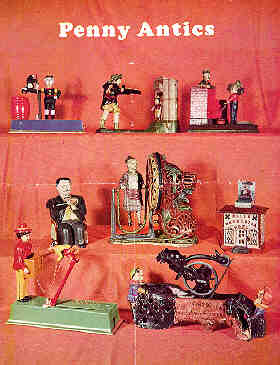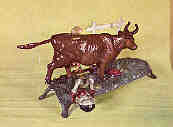Penny Antics
By Eleanor Harvill
 BACK in the days when a penny’s worth of candy was a
mouthful, one of the problems of parenthood was how to divert potential tummy aches into
Lilliputian bank accounts. Fathers and mothers shamelessly devised elaborate mental booby
traps to separate the kids from their coppers. Up in New England, a Yankee named John Hall
was so ingenious at this that in his hands it became a new form of art.
BACK in the days when a penny’s worth of candy was a
mouthful, one of the problems of parenthood was how to divert potential tummy aches into
Lilliputian bank accounts. Fathers and mothers shamelessly devised elaborate mental booby
traps to separate the kids from their coppers. Up in New England, a Yankee named John Hall
was so ingenious at this that in his hands it became a new form of art.
Hall’s first creation, patented in December 1869, was a little cast iron building with these words across the front: "Hall’s Excelsior Bank." Beside the front door was a tiny chain pull doorbell. Atop the building was a cupola hinged to the roof. A pull on the doorbell chain would lift the cupola and up would pop a wooden monkey seated at a desk marked "cashier." The monkey’s head would wag from side to side until a penny was placed on the desk. Then the monk would bow his thanks and take the coin inside with the cupola shut behind him.
It was worth a penny of any juvenile allowance to see the monk perform. And, thrift being the virtue it was in those times, enterprising iron foundries spent a generation in brisk competition for an entertainment market that now belongs to the comic books.
 As the lure of adventure wore off the simpler mechanisms, more
involved attractions had to be substituted. Among the most fanciful was a baseball pitcher
who tossed a coin to a catcher past a batter who swung and missed.
As the lure of adventure wore off the simpler mechanisms, more
involved attractions had to be substituted. Among the most fanciful was a baseball pitcher
who tossed a coin to a catcher past a batter who swung and missed.
At that time, most mechanical banks cost a dollar or two. All were made for children. Today they bring from $10 to $300, rate as rare antiques, and generally belong to rich men.
Professional collectors still find intricate specimens of this lost art in old barns, attics and forgotten trunks. Occasionally, they rescue a neglected one from service as a doorstop. But the finest are securely locked, under glass, in a dozen private collections like that on view at the two offices of the Seamen’s Bank for Savings in New York. The photographs in the adjoining columns were taken at the bank, through the courtesy of treasurer Thornton C. Thayer, who personally guards these precious relics of old-fashioned childhood.
 HOW THEY PERFORM: Bossy, above, kicks her milker flat when a
penny is dropped on her back. The dentist, below, pulls a tooth when a coin falls into his
pocket. And the characters on the page to the left disport themselves variously in return
for similar bribes. Top left, the trick dog jumps through a hoop. Center, William Tell
shoots his crossbow at the apple. Right, two bricklayers wield hod and trowel. Middle
left, a fat-paunched politician does the obvious; center, a girl skips rope; right, the
monk behaves as described in the text of this article. Lower left, the organ grinder
collects from his furred confree; right, "Prof. Pugfrog" takes a bicycle ride.
HOW THEY PERFORM: Bossy, above, kicks her milker flat when a
penny is dropped on her back. The dentist, below, pulls a tooth when a coin falls into his
pocket. And the characters on the page to the left disport themselves variously in return
for similar bribes. Top left, the trick dog jumps through a hoop. Center, William Tell
shoots his crossbow at the apple. Right, two bricklayers wield hod and trowel. Middle
left, a fat-paunched politician does the obvious; center, a girl skips rope; right, the
monk behaves as described in the text of this article. Lower left, the organ grinder
collects from his furred confree; right, "Prof. Pugfrog" takes a bicycle ride.
